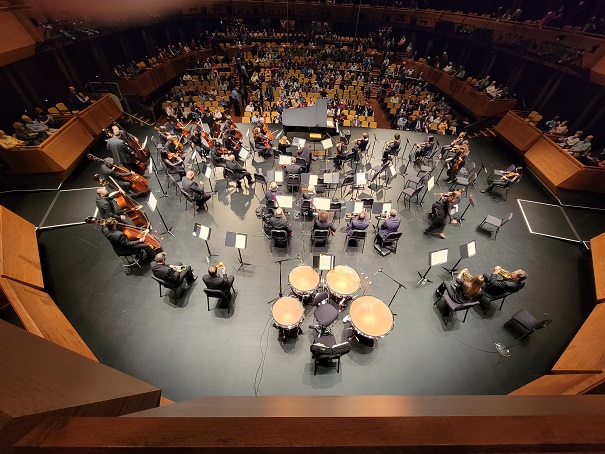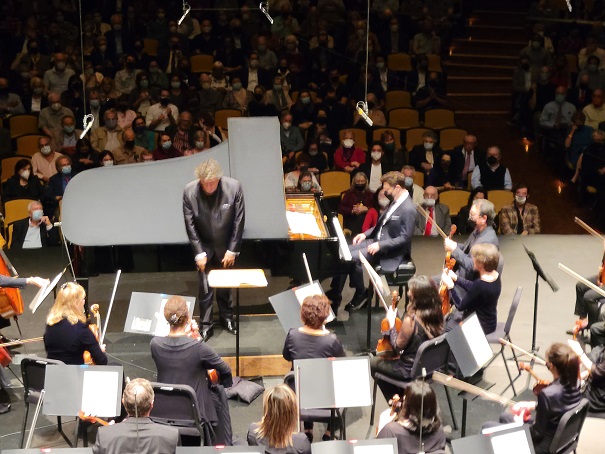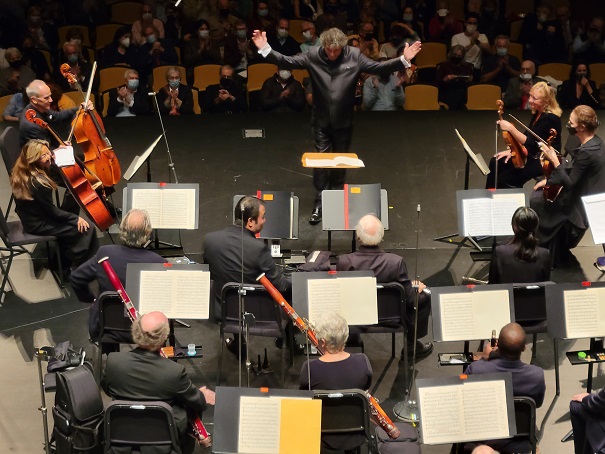Concert Diary: Brahms and the Schumanns with the New York Philharmonic
October 15, 2021
New York, N.Y.
On TV I see a scary universe where crazy people are yelling about face masks and vaccinations. Here in New York City, most of us are thankful that vax cards are required for entry to concerts and other events, and face masks are required for the duration. These concerts wouldn’t be happening otherwise!
Yesterday evening, Deirdre and I saw the New York Philharmonic for the first time in I don’t know how long. The orchestra is away from home: Another round of renovations are being applied to David Geffen Hall (formerly known as Avery Fisher Hall, formerly known as Philharmonic Hall), so this season’s performances are being divided among three other venues.
The first of these alternative venues is Rose Theater, part of Jazz at Lincoln Center at Columbus Circle. Our seats were above the rear of the orchestra, hovering over the timpani, giving us quite an unusual perspective:
The scheduled conductor was Music Director Japp van Zweden, and the scheduled pianist was Leif Ove Andsnes, but neither could make it this evening, so we got two exciting New York Philharmonic debuts with Nicaraguan-born conductor Giancarlo Guerrero and Italian pianist Alessio Bax. Here they are ready to get down and party:
The program was entitled "Brahms and the Schumanns". Interestingly, I saw a chamber music concert of Brahms and the Schumanns just a month ago. Unfortunately for this program, Clara Schumann was shortchanged. While Robert was represented by his giant Piano Concerto, Clara was barely more than an asterisk, represented by her four-minute Romance in A Minor for solo piano.
Why couldn’t Clara’s Piano Concerto also be performed? Well, it would have made the program 15 minutes longer, and probably require an intermission, which the orchestra prefers to skip to avoid lots of people milling around. But another reason is that Clara’s work is also often cited as “immature.” True, she wrote it as a teenager and premiered it a month after her 16th birthday, but that is notable in itself: As Clara expert Sarah Fritz notes, she was younger than Brahms, Robert, or even Mozart when they wrote their first piano concertos, and it also served as a model for both Robert and Brahms. It would have been great to hear it!
Instead, we got something quite unusual: The entire orchestra, conductor, and pianist took their positions, and then Alessio Bax very effectively played Clara’s Romance in A Minor as a type of prelude: Immediately after its conclusion, the orchestra launched right into the dramatic opening of Robert’s Piano Concerto. It was a startling transition, but unfortunately with the collateral damage of wiping Clara’s music entirely from our minds.
I love the first movement of Robert Schumann’s Piano Concerto, exploring moods both triumphant and contemplative. After that it gets rather mysterious to me. I’ve never been able to crack the meaning of the second movement Intermezzo, which leads right into the majestic finale and also (at least to me) continues to hide away impenetrable mysteries.
For the conclusion of the program, the piano was moved aside and chairs were rearranged for the reduced orchestra required for Brahms’ Serenade No. 2, which peculiarly uses no violins.
This Brahms Serenade is perhaps my least favorite music of the composer, lacking the majesty of the symphonies, lacking also the tangled complexity of the chamber music, and lacking the passion of both. The first movement is altogether too pleasant, and the second movement is altogether too happy. It isn’t until the middle Adagio that the dark-hued tones of this unusual ensemble create something quite exquisite. But then comes the dopey minuet.
But hey — it’s live music and much preferable to the silence of Covid lockdowns.
Here is maestro Guerrero asking the orchestra to rise at the conclusion:


